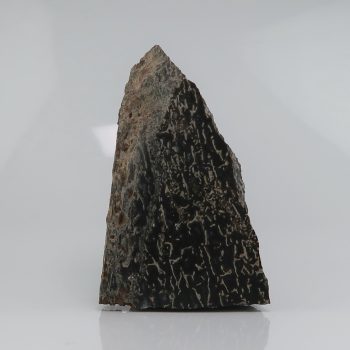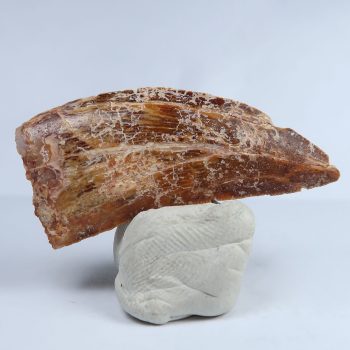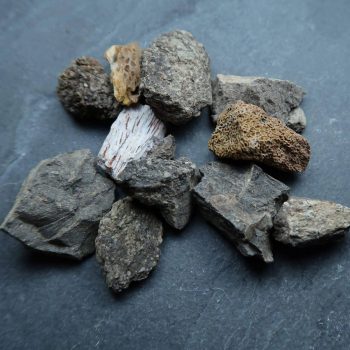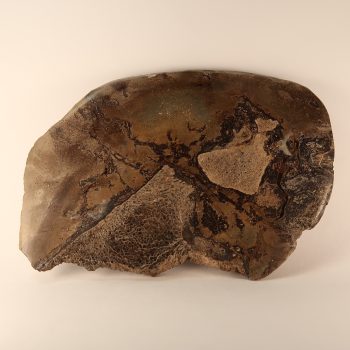Dinosaur Fossils
These ancient fossils are the preserved remains of ancient dinosaurs, from a wide range of species and subspecies.
Dinosaurs are “the big one”, of course – most kids have been or are obsessed with them!
Bone fragments are the most common fossil found, but eggs, teeth, and claws are amongst the most prized.
Showing all 4 results
-

Atlasaurus dinosaur bone – polished slices
£12.50 -

Carcharodontosaurus dinosaur tooth
£200.00 -

Dinosaur Bone Fragments (Unidentified)
£0.60 – £15.00 -

Iguanodon Dinosaur Bone – polished slices
£12.00 – £15.00
Information about Dinosaur Fossils
These fossils are gorgeous ancient specimens of the bones of dinosaurs – millions of years old, and turned to stone over the ages.
The words ‘dinosaur bone’ conjure up images of giant ribs suspended from the ceiling in a museum, but this is not always the case – there are many small pieces, or broken pieces of bone that can be found.
Teeth, bone fragments, bone pieces, and a wide range of other items can be found at reasonable prices – in the UK a large amount of our specimens come from the Isle of Wight.
They contain a range of minerals, which may include Hematite, Calcite, and Agate – the most desirable pieces of bone have many colours, and show the different cells and structures of the bone itself off beautifully. These pieces are often polished and sold as jewellery.
It is sometimes known as ‘petrified dinosaur bone’ or ‘fossilised dinosaur bone’. Americans may know it as ‘fossilized dinosaur bone’ because they don’t like the letter S. 🙂
In the past, dinosaur bones were confused with the bones of giant humans, or titans – sometimes the subject of myth and legend.
Well known species
There are several ways of categorising dinosaurs, but perhaps the simplest is to split them into carnivores, herbivores, and omnivores.
We can also use a more scientific division, into theropods, sauropods, and ornithischians.
As of 2021, there are at least 1500 named dinosaur species, with new species still being found.
Ornithischian dinosaurs
Probably the least recognised dinosaur group. They were herbivorous, and characterised by a pelvis similar to birds – however, birds are only a distant relative.
Sauropod dinosaurs
Herbivores, often with very long necks and tails, small heads, and large legs. They were some of the largest animals to have ever lived on land, with even the smallest measuring 5 to 6 metres long and the largest potentially 34-36 metres.
Theropod dinosaurs
Characterised by hollow bones and three toed limbs. They were originally carnivorous, but members of the group later evolved to become herbivores, insectivores and omnivores. Members of the theropod family eventually evolved into birds.
Some of the most famous and well known dinosaurs include:
Albertosaurus
A genus of theropod dinosaur that lived in North America during the late Cretaceous, between 76 and 71 million years ago. It is named after the Alberta province of Canada, where it is found in the Horseshoe Canyon formation.
Allosaurus
A genus of large theropod dinosaur that lived 155 to 145 million years ago during the late Jurassic. They are estimated to have been between 8 to 10 metres long.
Ankylosaurus
A genus of armoured dinosaur which dates to the very end of the Cretaceous, around 68-66 million years ago, which means members of this genus were amongst the last non-avian dinosaurs.
Apatosaurus
A genus of herbivorous sauropod that lived in North America during the late Jurassic, around 152 – 151 million years ago.
Archaeopteryx
A genus of bird-like dinosaurs. Generally accepted as one of the oldest known birds, it lived in the late Jurassic around 150 million years ago. It is theorised to be a transitional species between non-avian dinosaurs and birds. As its feathers were reasonably advanced, it serves as evidence that feathers were in development before the late Jurassic.
Argentinosaurus
A genus of large sauropod dinosaur that lived during the late Cretaceous. It is one of the largest known of all dinosaurs, and all land animals known. It was estimated to be between 30 and 40 metres long and weigh upwards of 50 tons.
Barney and friends
Barney is a fictional purple Tyrannosaurus rex off the telly, dating to the late Holocene (30-0 years ago!). It is unlikely T Rex was actually purple and fluffy, but you never know, eh.
Baryonyx
A genus of theropod dinosaurs that lived during the early Cretaceous, around 130-125 million years ago. A 1980s discovery in Surrey was one of the most complete theropod dinosaur skeletons ever found in the UK.
Brachiosaurus
A genus of sauropod dinosaurs that lived during the late Jurassic period, between 154 and 150 million years ago, approximately. They were around 18-20 metres long, and 9-13 metres tall. They were seen grazing tall vegetation in one of the most memorable (non action) scenes of Jurassic Park.
Brontosaurus
A genus of large sauropod dinosaurs, with a long thin neck well adapted for a herbivorous lifestyle. It lived during the late Jurassic, approximately 156 to 145 million years ago. Brontosaurus is one of the most recognisable sauropods and has been made famous by many depictions in media, advertising, etc.
Carcharodontosaurus
A genus of large theropod dinosaur that existed during the late Cretaceous, in North Africa. Their length was estimated to be between 12 and 14 metres approximately; it would have been amongst the largest dinosaurs. I’ve seen the teeth sold online as “African T-Rex”, which is not accurate.
Chickens
Eh, kind of, but also not really, but kind of. Birds descended from the dinosaur group known as theropods, so they could arguably be described as modern dinosaurs.
A study of proteins recovered from a T. rex fossil showed that chickens are the most similar animal currently alive, and there are many similarities between the two – bad attitude included.
Deinonychus
A genus of theropod dinosaurs which lived in the early Cretaceous, around 115-108 million years ago. It was closely related to the more well known Velociraptor of Jurassic Park fame.
Diplodocus
A genus of sauropod dinosaurs, which lived in the late Jurassic, around 154-152 million years ago. The Diplodocus fossil known as Dippy is probably the most well known dinosaur skeleton in the world.
Edmontosaurus
A genus of Ornithischian dinosaur, which has been found in rocks dating between 73 and 66 million years ago. It was one of the last non-avian dinosaurs, shortly before the K-Pg extinction event.
Giraffatitan
A genus of extremely large sauropod dinosaurs that lived during the late Jurassic in the area that is now Tanzania.
Hadrosaurus
A genus of ornithopod dinosaurs that lived in North America between 80 and 78 million years ago. It is thought to have had a hard beak for nipping foliage and leaves.
Iguanodon
A genus of ornithopod dinosaur that lived during the early Cretaceous period, 140-110 million years ago. It was herbivorous and had some adaptations for plant eating A genus of horn-like beak, and possibly a long tongue.
Iguanodon had a wide geographical distribution; however, many specimens have been found on the Isle of Wight, with other famous specimens found in Sussex and Kent. The specimens discovered in Sussex in 1822 by Mary Ann Mantell were the second identified form of dinosaur genus, although the word dinosaur had not yet been invented.
Megalosaurus
A genus of carnivorous theropod which lived between 208 and 66 million years ago, and seems to have had a limited geographical distribution – all the certain specimens have been found in southern England.
Megalosaurus was the first dinosaur to be discovered – a fragment was discovered in 1676 which was originally declared to be a bone from a giant human, or a titan.
Microraptor
A genus of small genus of theropod dinosaurs with four wings, dating from the early Cretaceous. Fossil specimens such as this and Archaeopteryx provide scientists with valuable information regarding the divergence between dinosaurs and birds.
Oviraptor
A genus of theropod dinosaurs that lived in Asia during the late Cretaceous – 85-75 million years old. An important scientific amount of Oviraptor egg clutches and nests are found in the Nanxiong formation of Guangdong province, China.
Patagosaurus
A genus of sauropod dinosaurs which lived during the Middle Jurassic of Patagonia, Argentina – hence the name. They would have been herbivorous and quite large, weighing around 15 tons.
Patagotitan
Another sauropod genus from Patagonia, Argentina. Patagotitan weighed around 55 tons and would have been one of the largest land animals of all time. It lived during the late Cretaceous, 102 to 95 million years ago.
Protoarchaeopteryx
A genus of feathered theropod dinosaurs from China, which lived in the early Cretaceous, around 124 million years ago. Scientists suspect it wouldn’t have supported flight, and may have acted like a flying squirrel.
Raptor
Raptor is a term, rather than a genus. It is not really a scientific term, either, and perhaps shouldn’t be used as often as it is – blame Jurassic Park.
It is now generally used informally to refer to small to medium ‘bird-like’ dinosaurs known as dromaeosaurids such as Gigantoraptor, Utahraptor, Velociraptor, and Dromaeosaur. In Jurassic Park, the dinosaurs known as raptors were based on Deinonychus.
Spinosaurus
A genus of large theropod that lived during the late Cretaceous, between 95 and 70 million years ago. It is often found in Morocco, with many, many teeth available online – but the dinosaur is only known from fragmentary remains. It is estimated to have been up to 18 metres long, being one of the longest dinosaurs.
It was the largest of all known carnivorous dinosaurs and was the antagonist of Jurassic Park 3.
Stegosaurus
A genus of herbivorous armoured dinosaurs from the late Jurassic, and one of the most famous and recognisable dinosaurs.
Their fossil remains have been found in the USA and in Portugal, in strata dating to between 155 and 145 million years ago.
Triceratops
Another tremendously recognisable dinosaur, triceratops was a genus of herbivorous ornithischian dinosaur which lived in the late Cretaceous, between 68 and 66 million years ago.
Its three large bony horns and ‘beak’ may have been a form of protection, but they were also likely used for other functions too, much like modern rhinos.
Tyrannosaurus
The big bad of every dinosaur movie.. Tyrannosaurus was a genus of theropod dinosaur which has been found in North-West America between 68 and 66 million years ago.
It was one of the largest land predators and would have been either an apex predator or a predator which also scavenged – why not steal a smaller predators kill, afterall?
Some specimens of T. rex are nearly complete, including, amazingly, soft tissues and proteins. This has allowed a huge amount of research into its biology.
In 2007 a study was released showing proteins recovered from T. rex fossils to be most closely matching to modern day chickens.
T rex is thought to have able to run at between 10 and 20 miles an hour, but this is only an estimation, and other scientists consider they may have been adapted to a pursuit type of predation -a long distance of stalking and a short sprint – similar to modern wolves (and human beings!).
It would have been a fine tracker with excellent eyesight, hearing, and sense of smell.
T. rex is by far the most widely recognised name of a dinosaur, one of the few that is also known by its full scientific name of Tyrannosaurus rex (tyrant lizard king).
Utahraptor
Utahraptor is a genus within the family Dromaeosauridae, small to medium feathered carnivorous dinosaurs that lived during the Cretaceous period between 112 and 100 million years ago.
It is one of the dinosaurs most people would refer to as ‘raptors’ and is one of the largest dromaeosaurids, making it slower than its relatives. In 2021, Utahraptor State Park was created in the US, protecting the area in which many fossils were discovered.
Velociraptor
Another genus within the family Dromaeosauridae, small to medium feathered carnivorous dinosaurs. Velociraptor lived during the Cretaceous, around 75-71 million years ago.
It was a relatively small bipedal carnivore, made famous by its appearance in Jurassic Park.
However, true Velociraptors would have been around the size of a turkey, around 50CM tall. They probably weighed between 15-20KG as adults. In 2007 a specimen was found with quill knobs, proving Velociraptor had ‘wing’ feathers, although it may not have been capable of flight.
Things that are not dinosaurs:
Crocodiles
Crocodiles are similar looking to some depictions of dinosaurs, but they are not dinosaurs. They do share a common ancestor, the archosaurs – a reptile group that included dinosaurs, birds, and crocodiles.
Ichthyosaur
An order of large, extinct marine reptiles. They existed from between 250 to 90 million years ago, and resembled modern dolphins.
Megalodon
An extinct form of shark that lived around 23 to 3.6 million years ago.
It is a matter of debate which genus it is placed into – however, the most commonly used only is Carcharocles, which could easily be confused with the dinosaur known as Carcharodontosaurus.
Mosasaur
A group of extinct marine reptiles or aquatic lizards, which lived from around 145 to 66 million years ago, becoming extinct in the K-Pg extinction event.
They would have competed with Plesiosaurs and Ichthyosaurs for food sources. As a group, their adaptations and food sources varied, but included ammonites, fish, cuttlefish, shellfish and sometimes, other Mosasaurs.
Nessie (the Loch Ness Monster)
Possibly an ichthyosaur, plesiosaur, pliosaur, or (more likely) fictional. Still not a dinosaur.
Plesiosaur
A genus of extinct marine reptiles which lived from around 240 to 66 million years ago. Almost complete skeletons have been discovered in the UK – including some specimens from Lyme Regis by the English palaeontologist Mary Anning.
Pliosaurus
A genus of extinct marine reptile that lived around 220 to 70 million years ago. Unfortunately due to the naming they are often confused with plesiosaurs.
Pterodactyl
The order Pterosauria are often thought of as dinosaurs – probably another side effect of Jurassic Park. However, they were flying reptiles.
Pterosaurs had a variety of lifestyles and diets, including hunting land animals, fish, insects, and even other pterosaurs.
Distribution
Dinosaur fossils are found worldwide, with specimens found on every continent including Antarctica.
Some of the best dinosaur fossil sites in the world are in the USA, especially in Montana, Wyoming, and North and South Dakota. In Canada, Alberta has a provincial park with a great variety of fossil species.
China has some of the most important dinosaur fossil sites in the world, and clusters of dinosaur eggs are found from time to time. There is a good article on dinosaur sites in China here.
Closer to home, dinosaur fossils have been found in various UK locations, especially on the Isle of Wight, around the Jurassic Coast, Lavernock, and Whitby – however, dinosaur tracks are discovered on various beaches surprisingly often – although it always makes the news!
Time period
Dinosaurs existed for around 174 million years, from around 240-230 million years ago up until around 66 million years ago.
This means dinosaurs first appeared during the Triassic period, and thrived up until the end of the Cretaceous period, when the K-Pg extinction wiped out approximately three quarters of all plant and animal life on Earth – including all of the non-avian dinosaurs.
Many other forms of life were killed off in this event, including some mammals, birds, lizards, insects and ammonites.
It is possible some smaller non-avian dinosaurs existed after the K-Pg event, but due to gaps in the fossil record that remains mostly academic speculation.
Further reading
- https://www.livescience.com/3945-history-dinosaurs.html#section-what-is-the-largest-dinosaur-the-smallest-dinosaur
- https://www.nhm.ac.uk/discover/dino-directory.html
Books
- Dinosaurs: The Most Complete, Up-to-Date Encyclopedia for Dinosaur Lovers of All Ages [Amazon UK]
- Dinosaurs and Other Prehistoric Life [Amazon UK]
- Dinosaurs and Prehistoric Life: The definitive visual guide to prehistoric animals [Amazon UK]
